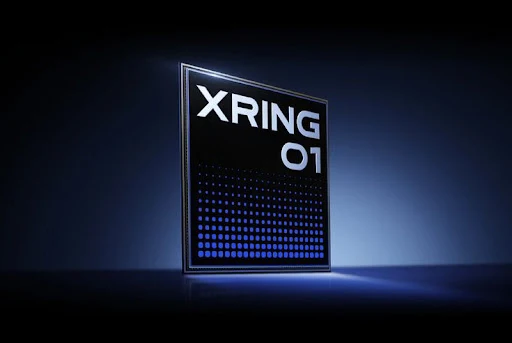Xiaomi Xring O1: Breaking the Silicon Monopoly with a Flagship Chipset 🚀
After four years of development and a $1.87 billion investment, Xiaomi has entered the high-end SoC arena with its self-designed Xring O1 chipset. Announced in May 2025, this 3nm powerhouse challenges industry giants like Qualcomm and MediaTek while signaling Xiaomi's ambition to control its silicon destiny. Let's dissect what makes this debut revolutionary ⚡ .
🔬 Architectural Deep Dive: Inside Xiaomi’s 3nm Marvel
Built on TSMC’s second-generation 3nm process (N3E), the Xring O1 packs 19 billion transistors into a compact 109mm² die – matching Apple’s A18 Pro in size but with a radically different design philosophy .
⚙️ CPU: Quad-Cluster Dynamism
- Cores: 10-core configuration with four distinct clusters:
- 2× Cortex-X925 @ 3.9 GHz (ultra-performance)
- 4× Cortex-A725 @ 3.4 GHz (high-performance)
- 2× Cortex-A725 @ 1.9 GHz (efficiency-optimized)
- 2× Cortex-A520 @ 1.8 GHz (ultra-efficiency)
- Cache: Innovative distributed design:
- 2MB L2 per X925 core + 1MB L2 per A725 core (total 10MB L2)
- 16MB shared L3 cache (no system-level cache)
- ISA: ARMv9.2-A
This dual-tier A725 setup allows dynamic core switching for optimal power efficiency, reducing reliance on the A520 cores .
🎮 GPU: Immortalis Pushed to the Limit
- Model: Mali-G925 Immortalis MP16
- Architecture: Valhall 5th Gen
- Clock Speed: 1392 MHz
- Shading Units: 128
- Compute Power: 5,701.6 Gigaflops ⚡
- Cache: 4MB dedicated
The 16-core GPU boasts 33% more cores than MediaTek’s Dimensity 9400, though it trades peak clock speed for core count .
🧠 NPU & Accelerators: Custom AI Beast
- NPU: 6-core custom Xiaomi design
- Performance: 44 TOPS (INT8)
- Cache: 10MB – nearly matching the CPU’s footprint
- ISP: 4th-gen Xiaomi image processor supporting 8K/30fps video
The NPU’s massive cache underscores Xiaomi’s focus on AI tasks like computational photography and real-time translation .
💾 Memory & Connectivity
- RAM: LPDDR5T @ 4800 MHz (76.8 Gbit/s bandwidth)
- Storage: UFS 4.1
- Modem: MediaTek T800 external modem (7,900 Mbps down / 4,200 Mbps up)
- Wireless: Wi-Fi 7 + Bluetooth 5.4
Note: LPDDR5T is technically LPDDR5X-9600 under JEDEC standards, despite branding debates .
📊 Performance Benchmarks: Real-World Prowess
| Benchmark | Xring O1 | Details |
|---|---|---|
| AnTuTu v10 | 2,501,370 | Peak: 2,815,509 (Xiaomi 15S Pro) |
| GeekBench 6 | Single: 3,086 Multi: 9,701 |
∼15% faster than Dimensity 9400 in multi-core |
| Power Efficiency | 35% lower GPU power vs A18 Pro | Dynamic scheduling optimizes thermals |
In light-to-moderate workloads, efficiency rivals Apple’s A18 Pro – a triumph for a first-gen chip .
⚔️ Comparative Analysis: Flagship Showdown
Specification Comparison
| Feature | Xring O1 | Snapdragon 8 Elite | Dimensity 9400 |
|---|---|---|---|
| Process | TSMC 3nm | TSMC 3nm | TSMC 3nm |
| CPU Cores | 10 (2X+6A725+2A520) | 8 (2 Oryon+6 Oryon) | 8 (1X+3X4+4A720) |
| GPU | Immortalis MP16 | Adreno 830 | Immortalis MP12 |
| Peak Frequency | 3.9 GHz | 4.32 GHz ⚡ | 3.63 GHz |
| Memory Bandwidth | 76.8 Gbit/s | 85.4 Gbit/s ⚡ | 85.3 Gbit/s ⚡ |
| NPU TOPS | 44 | N/A | N/A |
Performance Metrics
| Metric | Xring O1 | Snapdragon 8 Elite | Dimensity 9400 |
|---|---|---|---|
| AnTuTu v10 | 2.5M | 2.74M ⚡ | 2.56M |
| GeekBench 6 SC | 3,086 | ∼3,200 ⚡ | ∼2,900 |
| GPU FLOPS | 5,701.6 | 3,379.2 | 4,952.1 |
| Modem | MediaTek T800 (ext) | X80 (integ) ⚡ | Integrated ⚡ |
Key Takeaways:
- Snapdragon leads raw CPU clocks (+11%) and AnTuTu scores .
- Xring dominates GPU compute (+69% vs Snapdragon) and multi-core efficiency .
- Dimensity strikes balance but trails in CPU innovation .
💡 Innovative Design Choices
- Cache Revolution: Eliminated system-level cache (SLC) in favor of oversized L3 (16MB) and distributed L2 – a risk that paid off for CPU efficiency .
- Asymmetric A725 Cores: Physically distinct high-performance and efficiency A725 clusters enable granular power management .
- External Modem: MediaTek T800 modem saves design complexity but increases power draw – a tradeoff for rapid market entry .
📱 Devices & Ecosystem Integration
The Xring O1 debuts in two devices:
- Xiaomi 15S Pro: Flagship phone with Leica optics and semantic AI features.
- Xiaomi Pad 7 Ultra: 14" tablet leveraging the chip’s thermal headroom.
Xiaomi plans a $6.9 billion, 10-year investment to expand Xring into EVs, IoT, and wearables .
🔮 Conclusion: More Than Just a Chip
The Xring O1 isn’t about beating Apple or Qualcomm today. It’s a statement that Xiaomi can design competitive silicon while reducing geopolitical risks. With class-leading GPU compute, revolutionary cache architecture, and a custom NPU, it lays groundwork for a vertically integrated future – where HyperOS, Leica cameras, and Xiaomi EVs speak the same silicon language 🌐 .
For deep dives into benchmark data, visit NanoReview’s comparison pages: Xring O1, vs Snapdragon, vs Dimensity.








0 Comments